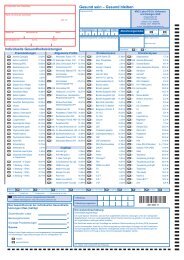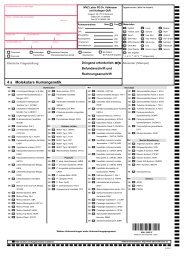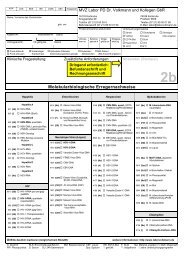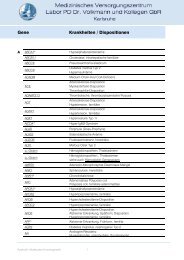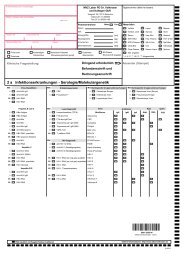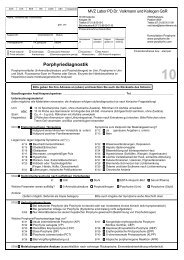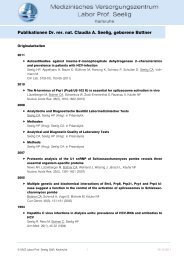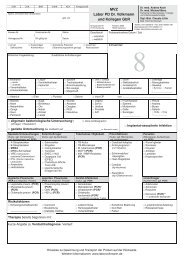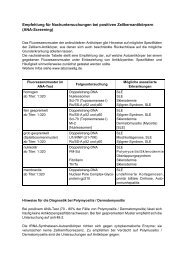ORIGINAL ARTICLE - MVZ Labor PD Dr. Volkmann und Kollegen
ORIGINAL ARTICLE - MVZ Labor PD Dr. Volkmann und Kollegen
ORIGINAL ARTICLE - MVZ Labor PD Dr. Volkmann und Kollegen
You also want an ePaper? Increase the reach of your titles
YUMPU automatically turns print PDFs into web optimized ePapers that Google loves.
INTRODUCTION<br />
In the course of routine screening for autoantibodies<br />
against nuclear antigens by means of indirect immunofluorescence<br />
test (IIFT) with HEp-2-cells, we detected<br />
in the serum of a female patient an unusual cytoplasmic<br />
staining not described before. The antigenic target of<br />
this reaction was identified, by screening an expression<br />
library, as type 2 inosine-5’-monophosphate dehydrogenase<br />
(1) the key enzyme in the synthesis of purine<br />
nucleotides. Inosine-5’-monophosphate dehydrogenase<br />
(IM<strong>PD</strong>H), catalyzes the transition of inosine monophosphate<br />
to xanthine monophosphate, which constitutes the<br />
rate limiting step in the de novo synthesis of guanine<br />
nucleotides, precursors of RNA and DNA. In mammalian<br />
species there exist two isoforms, IM<strong>PD</strong>H1 and<br />
IM<strong>PD</strong>H2 (2), each of which is composed of 514 amino<br />
acids (55.8 kDa) with a homology of 84 % on amino<br />
acid level. Whilst IM<strong>PD</strong>H1 is constitutively expressed<br />
in normal cells, the expression and activity of IM<strong>PD</strong>H2,<br />
however, is augmented in proliferating normal and malignant<br />
tissues and cells, in malignant transformation,<br />
and differentiation (3–9). The possible occurrence of<br />
autoantibodies against IM<strong>PD</strong>H2 was reported in the serum<br />
of one out of 21 patients with autoimmune hepatitis<br />
(10), studied by immunoproteomic analysis of HepG2<br />
cell proteins. Contemporaneously to our findings it has<br />
been shown, that IM<strong>PD</strong>H2 probably acts as a tumor associated<br />
antigen (11). Our patient, however, showed no<br />
evidence of a disease related to cell proliferation or neoplasm<br />
nor could her clinical symptoms be associated to<br />
the presence of autoimmune hepatitis or another autoimmune<br />
disease. Subsequently, we detected IM<strong>PD</strong>H2<br />
autoantibodies by IIFT in four patients who suffered<br />
from chronic hepatitis C virus (HCV) infections. HCV<br />
infection may be involved in the pathogenesis of various<br />
autoimmune and rheumatic disorders and chronically<br />
infected HCV patients have been reported to produce<br />
a plethora of autoantibodies (12–17). We determined<br />
the presence of anti-IM<strong>PD</strong>H2 in patients with HCV infections,<br />
hepatitis B virus (HBV) infections, autoimmune<br />
liver diseases, and rheumatic diseases.<br />
Anti-IM<strong>PD</strong>H2 was detected in patients harboring HCV<br />
infections and autoimmune liver diseases. We could<br />
show that the so-called “rods and rings” fluorescence<br />
pattern (18), which sometimes can be seen within the<br />
cytoplasm of some commercial HEp-2 cell preparations<br />
used for screening of autoantibodies, is caused by anti-<br />
IM<strong>PD</strong>H2. This finding may be important particularly<br />
with regard to considerations concerning the pathogenesis<br />
of IM<strong>PD</strong>H2 autoantibodies since it has been shown<br />
that the IM<strong>PD</strong>H2 inhibitor mycophenolic acid causes<br />
reversible intracellular aggregations of IM<strong>PD</strong>H2 molecules<br />
(19), which impress as “rods and rings” shaped<br />
structures. As could be shown here, ribavirin, an inhibitor<br />
of IM<strong>PD</strong>H2 used in treatment of HCV infections,<br />
also causes an aggregation of IM<strong>PD</strong>H2 in “rods and<br />
rings” structures. Possibly the aggregated enzyme attains<br />
a higher degree of immunogenicity, promoting the<br />
H. P. SEELIG et al.<br />
754<br />
development of autoantibodies in patients treated with<br />
IM<strong>PD</strong>H2 inhibitors. The preferred origination of autoantibodies<br />
against constituents of subcellular aggregates<br />
and particles is debated and evidenced since more than<br />
two decades (20-24).<br />
MATERIALS AND METHODS<br />
Patient and control sera<br />
The index patient was a 71-year-old female (HCV-RNA<br />
negative), suffering for 15 years from extended osteoporosis<br />
who <strong>und</strong>erwent pain management therapy because<br />
of major osteoporotic ache. To exclude systemic rheumatic<br />
disease, a search for antinuclear antibodies was<br />
performed with a negative result. However, the current<br />
investigation by indirect immunofluorescence tests<br />
(IIFT) revealed a distinct cytoplasmic staining in HEp-<br />
2-cells not attributable to a known autoantibody. The<br />
serum precipitated a 55 kDa protein from 35 S-methionine<br />
labeled HEp-2 cell proteins and an expression library<br />
was screened, which revealed IM<strong>PD</strong>H2 as the reactive<br />
antigen.<br />
To establish the prevalence of anti-IM<strong>PD</strong>H2, we<br />
screened (by IIFT, immunoblot, and radioimmunoprecipitation<br />
assay (RIPA)) the sera of patients positive for<br />
HCV-RNA (n = 108) and of disease controls (hospitalized<br />
patients) negative for HCV-RNA (n = 100), sera of<br />
patients positive for HBV-DNA (n = 113), with mitochondrial<br />
antibodies (AMA Type M2, suspected primary<br />
biliary cirrhosis; n = 31) or actin antibodies (suspected<br />
autoimmune hepatitis; n = 42), with overt or suspected<br />
rheumatic diseases showing antibodies against<br />
nuclear antigens (n = 51) with different nuclear staining<br />
patterns (homogeneous, speckled, nucleolar, rim), and<br />
the sera of healthy blood donors (n = 100).<br />
Screening of autoantibodies (actin, tubulin, mitochondria,<br />
microsomes, ribosomes, lysosomes, endosomes,<br />
tRNA synthetases, Golgi proteins), HCV-RNA, and<br />
HBV-DNA was performed by approved, CE labeled in<br />
house tests according to Quality Systems of the Council<br />
Directive 98/79/EC. All samples were coded and analysed<br />
for the presence of anti-IM<strong>PD</strong>H2 without knowledge<br />
of virus and autoantibody status.<br />
cDNA library screening and synthesis of recombinant<br />
His(6)-tag IM<strong>PD</strong>H2 in E. coli<br />
Expression library screening and sequencing was performed<br />
by standard techniques using an oligo(dT)primed<br />
human HeLa cell cDNA expression library in<br />
Lambda ZAP (Stratagene, Amsterdam, The Netherlands)<br />
in conjunction with the index patient’s serum.<br />
Following two ro<strong>und</strong>s of screening, three clones were<br />
selected as positive and subjected to sequence analysis<br />
using ABI Prism 3130XL and the Cycle Sequencing Kit<br />
Big dye Terminator from Applied Biosystems (Darmstadt,<br />
Germany). Sequence homologies were identified<br />
using the NCBI BLAST program.<br />
Full length IM<strong>PD</strong>H2 containing a His(6)-tag was syn-<br />
Clin. Lab. 9+10/2011



